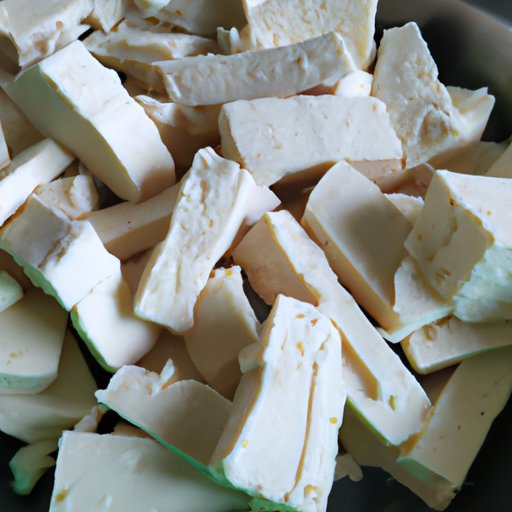
I. Introduction
Paneer is a soft, Indian cheese that has a mild, creamy flavor and a texture similar to extra-firm tofu. It is commonly used in Indian dishes such as curries, but can also be used in salads, sandwiches, and wraps. In this article, we will cover everything you need to know about making paneer at home, including why it’s worth making it from scratch.
II. Step-by-Step Guide to Making Paneer
To start making paneer at home, you will need a few basic tools such as a heavy-bottomed pot, cheesecloth, and a colander. For ingredients, you will need milk and an acidic substance like lemon juice or vinegar.
Instructions:
- Begin by slowly heating the milk in a heavy-bottomed pot over medium heat, stirring constantly to prevent it from scorching on the bottom of the pot.
- Once the milk reaches a simmer, start adding your acidic substance, stirring constantly, until the milk begins to curdle and the whey (the yellow, watery substance) separates from the curd (white, solid substance).
- Remove the pot from the heat and pour the curds and whey into a cheesecloth-lined colander set over a bowl, allowing the whey to drain out.
- Gather the cheesecloth around the curds and squeeze until most of the whey is removed (be careful not to squeeze too hard, as this can result in a dry, tough paneer).
- Rinse the curds under running water to remove any remaining acidic taste.
- Wrap the paneer in cheesecloth and press it between two flat surfaces (such as two plates with a heavy object on top) for 1-2 hours to remove any remaining excess whey and create a firmer texture.
- Unwrap and cut the paneer into cubes. Your homemade paneer is now ready to use!
One common mistake people make when making paneer is using too much acidic substance or heating the milk too quickly, resulting in a tough, rubbery texture. To avoid this, it’s important to heat the milk slowly, stirring constantly, and to stop adding the acidic substance as soon as the curdling process begins.
III. Recipe-Focused Article
Paneer is a versatile ingredient that can be used in a variety of dishes. Try seasoning and pan-frying it to add to salads or wraps, or marinating it in a flavorful sauce for use in curries.
Here is a simple recipe for paneer:
- Ingredients:
- 1 gallon whole milk
- 1/4 cup lemon juice or vinegar
- Instructions:
- Follow steps 1-5 from the main guide above.
- Cut the paneer into small cubes.
- Heat 1 tablespoon of oil in a non-stick skillet over medium heat. Add the paneer cubes and cook for 2-3 minutes on each side, until lightly browned and crispy on the outside.
Paneer can be used in a wide variety of dishes, including:
- Mattar paneer – a classic North Indian dish made with paneer and peas
- Shahi paneer – a rich, creamy curry made with paneer, cashews, and cream
- Paneer tikka masala – cubes of paneer marinated in a spiced yogurt mixture and grilled
For each dish, a quick internet search will give you plenty of options that will allow you to experiment with different flavors.
IV. Ingredient-Focused Article
The two main ingredients in paneer are milk and an acidic substance (such as lemon juice or vinegar). The acidic substance causes the milk to curdle and separates it into curds and whey. This method of making cheese is called acid coagulation.
The main difference between homemade and store-bought paneer is the quality of the milk used. Store-bought paneer is usually made from low-quality milk or milk powder, which can result in a less flavorful and less nutritious product. By using high-quality, whole milk, you can ensure that your homemade paneer is fresh and full of flavor.
When selecting milk for making paneer, it’s best to use whole milk. Low-fat or skim milk will result in a lower yield and less flavorful paneer.
V. Health Benefits of Paneer
Paneer is a great source of protein for vegetarians and is also low in carbohydrates. It is high in calcium, vitamin D, and other essential nutrients, making it a great addition to a balanced diet.
Paneer is also low in sodium, which makes it a great choice for individuals with high blood pressure.
VI. Paneer in Recipes
Paneer can be prepared in a variety of ways, including grilling, pan-frying, and baking. Store paneer in an airtight container in the refrigerator for up to 5 days, or freeze it for up to 6 months.
Here are some tips for cooking with paneer:
- Use a nonstick skillet when pan-frying paneer to avoid sticking
- Marinate the paneer before grilling for extra flavor
- Bake paneer cubes in a spicy tomato sauce for a satisfying vegetarian dish
VII. Conclusion
Now that you know how to make paneer at home, and why it’s a great addition to any meal, we encourage you to give it a try. Experiment with different recipes, cooking techniques, and spices to create your own perfect paneer dish.
For more information on paneer and its many uses, check out Indian cooking blogs and recipe sites.




